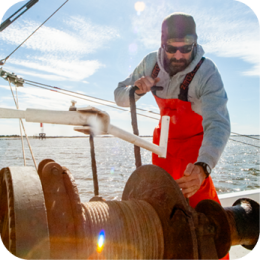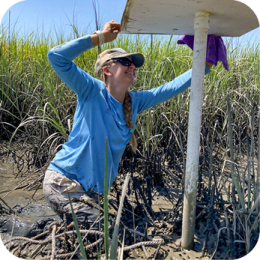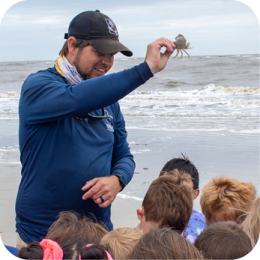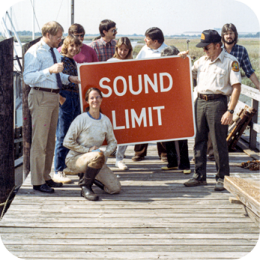
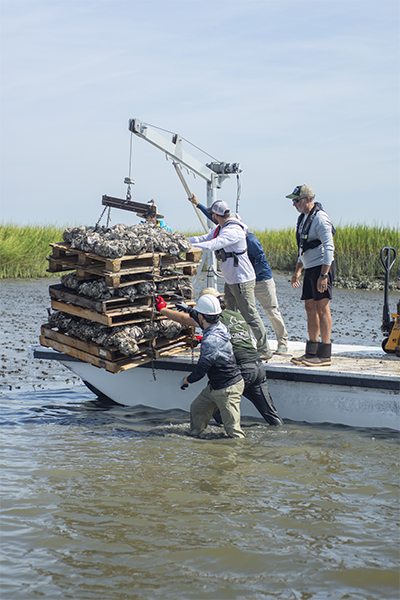
The Georgia Department of Natural Resources Coastal Resources Division (CRD) launched its latest oyster restoration project Monday in Liberty County west of St. Catherines Island.
Approximately 10 tons of bagged oyster shell are being stacked on pallets and placed at two locations on a northern bank of the North Newport River west of St. Catherines Island to encourage the growth of new, native Eastern oysters (Crassostrea virginica).
In addition to creating new essential habitat for marine life, the restoration project is a collaboration between CRD, Georgia Southern University (GSU), and Yamaha Rightwaters, a national sustainability program that encompasses Yamaha Marine’s conservation and water quality efforts. Yamaha Rightwaters is providing financial support for GSU to collect data that may help researchers determine the carbon-sequestration potential of oyster reefs in Georgia.
“Not only do established reefs provide important habitat for several kinds of sea life, they also reduce carbon dioxide and, in turn, reduce ocean acidification,” said John Carroll, associate professor of biology at Georgia Southern University. “The research from this Yamaha Rightwaters-supported project will provide us with Georgia-specific data that will ultimately help us determine the carbon burial potential of newly formed oyster reefs in Georgia.”
Oyster reefs are already known to provide a number of important ecological benefits, including filtering water, improving habitat for other marine life, and protecting shorelines from erosion. Now, GSU and Yahama Rightwaters want to learn if they can also offer carbon capture solutions.
“In 2022, we teamed up with Texas A&M University’s Harte Research Institute and the Coastal Conservation Association to initiate a similar conservation project designed to evaluate the role of oyster reefs in capturing and storing carbon in St. Charles Bay in the Gulf of Mexico. This new project in coastal Georgia allows us to do the same thing in the Atlantic,” said Martin Peters, director of External Affairs for Yamaha U.S. Marine Business Unit. “It’s our hope that the data collected through the two initiatives will give us more information about the carbon sequestration value of oyster reefs. The data will allow us to evaluate the possibility of increasing the scale of these programs to achieve a measurable result.”
The North Newport River and encompassing St. Catherines Sound is a popular destination for fishing, boating, and other recreational activities, with nearby access from the CRD-funded Demere Creek and Sunbury boat ramps. The St. Catherines Sound system is also an important habitat for a variety of marine life, including oysters, crabs, and fish.
“Oyster restoration is a critical component of protecting and restoring Georgia’s coastal ecosystems,” said Paul Medders, CRD’s Habitat Enhancement and Restoration Unit lead. “This project will help to reestablish oyster reefs in the North Newport River, which will benefit both wildlife and people.”
Benefits of Oyster Reefs
Oyster reefs provide many important ecological and economic benefits, including:
- Water filtration: Oysters are filter feeders, meaning they eat algae and other small particles in the water. This helps to improve water quality and clarity.
- Habitat enhancement: Oyster reefs provide important habitat for a variety of marine life, including finfish, crabs, and shrimp.
- Shoreline protection: Oyster reefs act as a natural buffer against erosion and storm damage.
- Economic benefits: Oyster reefs support a variety of commercial and recreational activities, including fishing, boating, and tourism.

Oyster Restoration Efforts
CRD has oyster restoration efforts underway across the Georgia’s 105-mile coast to help bring back oyster populations that have been depleted due to historical overharvesting, habitat loss, and other factors. One common restoration method employed by CRD is to place oyster shells in mesh bags and place them atop wooden pallets. These pallets are placed onto riverbanks using a davit from a pontoon barge. The placed oysters at artificial reefs provide the necessary substrate for natural oysters to grow and spawn in the ecosystem.
CRD has completed six oyster restoration projects in Georgia since 2018. The North Newport River oyster restoration project is part of the CRD’s ongoing efforts to restore and protect Georgia’s coastal ecosystems.
Additional Information
The North Newport River oyster restoration project is expected to take approximately two weeks to complete, depending on weather and tides. Once the project is complete, CRD will monitor the sites to assess the long-term success of the restoration effort, alongside GSU’s collection of data on carbon sequestration.
CRD encourages the public to get involved in oyster restoration efforts. There are a number of ways to get involved, including volunteering to help with restoration projects, donating oyster shell from backyard oyster roasts, and encouraging restaurants to become a shell donor to CRD.
Georgia drivers can also show their support for inshore and offshore artificial reef creation by purchasing CRD’s “Support Marine Habitat” license plate at their county tag office. Of the additional $25 it costs to have this unique, coastal car tag, $21 goes directly to CRD for habitat creation coastwide. Learn more at GaDNR.org/LicensePlates.
For more information about the Medway River oyster restoration project or other oyster restoration efforts in Georgia, please visit the CRD Habitat Enhancement and Restoration Unit website at CoastalGaDNR.org/HERU.
About the Coastal Resources Division
The mission of the Coastal Resources Division is to balance coastal development and protection of the coast's natural assets, socio-cultural heritage and recreational resources for the benefit of present and future generations.
Media Contact
Tyler Jones
Public Information Officer
Coastal Resources Division
Georgia Department of Natural Resources
tyler.jones@dnr.ga.gov
(912) 262-3140
Click here to download high-resolution photos with captions embedded in metadata.

